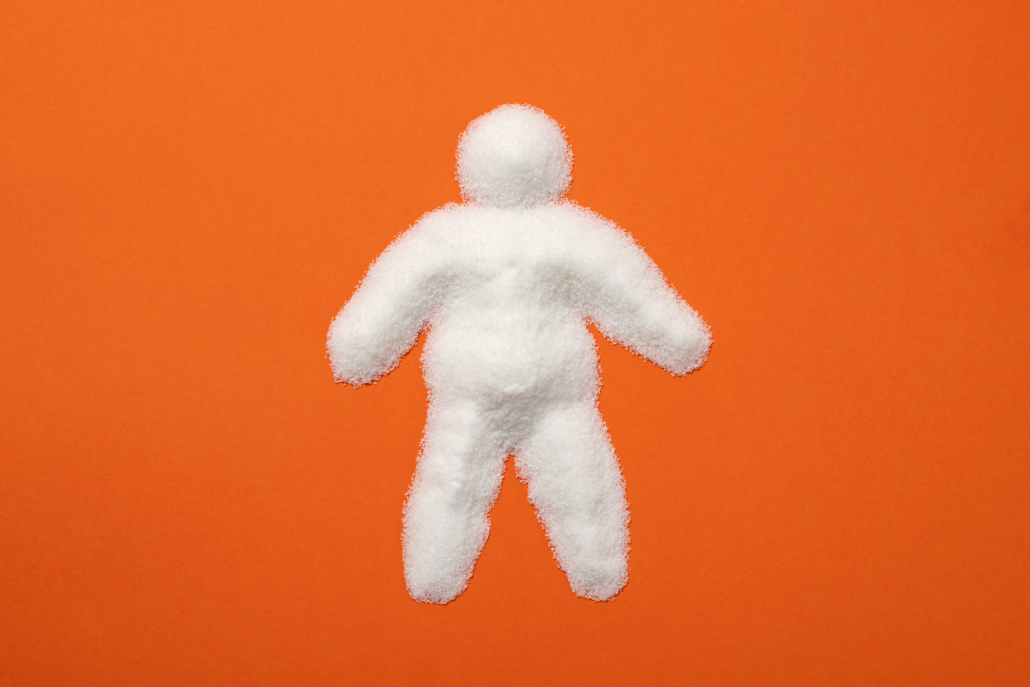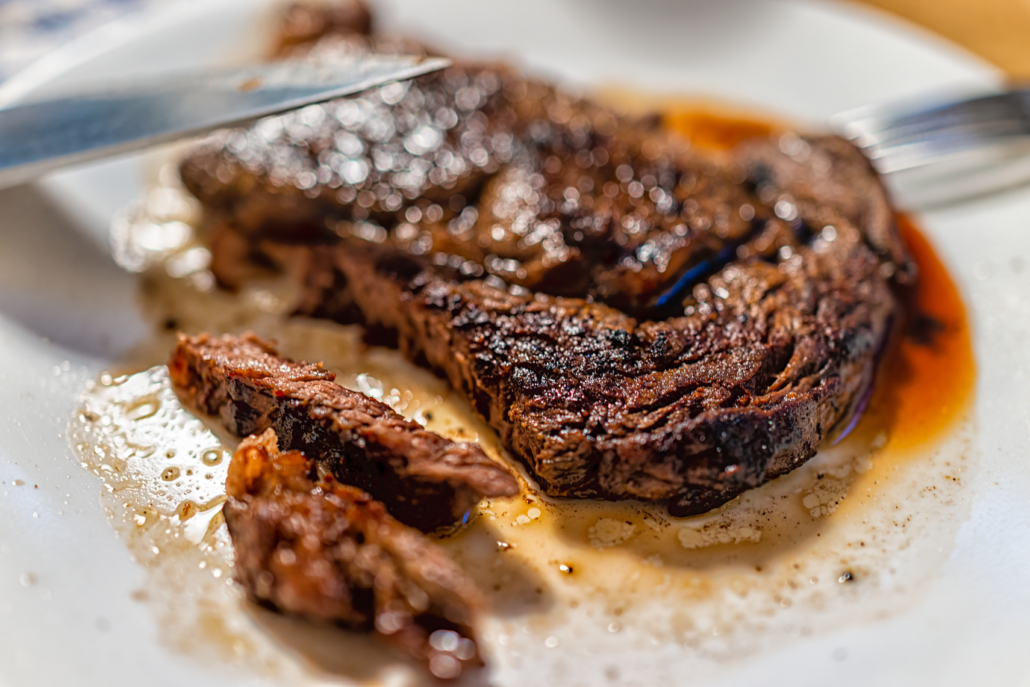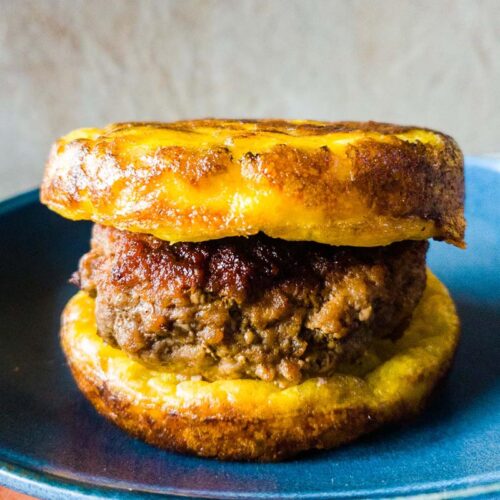We include products in articles we think are useful for our readers. If you buy products or services through links on our website, we may earn a small commission.
What Can You Eat on the Keto Diet? Complete List of Keto Foods

What can you eat on a keto diet? Probably a lot more than you first thought.
Most people think of keto as a restrictive diet, yet the only thing it truly restricts is carbs. However, since the Standard American Diet centered around processed carbs, you might feel you’re giving up a lot of familiar and comforting foods.
The good news, is that once you kick your carb addiction, you open up a new world of delicious, nutrient-dense whole foods.
Ironically, many of the best foods to eat on a keto diet, like beef, butter, eggs, lard, bacon, and organ meats, were staples for most of our ancestors.
So one way to look at what you can eat on a keto diet is that they’re the foods that mainstream nutrition has wrongfully demonized.
Eating Fat: What the Science Says
Fortunately, numerous recent high-quality studies are setting the record straight. For exaple:
- Eating more fat and less carbs reduces the risk of heart disease.1 2
- Saturated fat in whole foods is essential and does not contribute to heart disease.3
- Cholesterol in food does not raise cholesterol in your blood. 4
- Fiber is unnecessary, and high-fiber diets can be harmful. 5 6 7
Now let’s comprehensively answer the question: “What can you eat on the keto diet?”
Table of Contents
Chart of Foods You can eat on a Keto Diet
This chart provides an overview of the types of food you can eat on a keto diet. Below we’ll explore each category in more detail.
It’s important to remember that a keto diet is as much about eating high-fat as it is about low-carbs. The standard ketogenic diet macronutrient breakdown on keto looks like:
- 70-80% of calories from fat
- 15-30% calories from protein
- 0-10% calories from carbohydrate
The foods you can eat on a keto diet should be selected and combined to fit within these ratios.
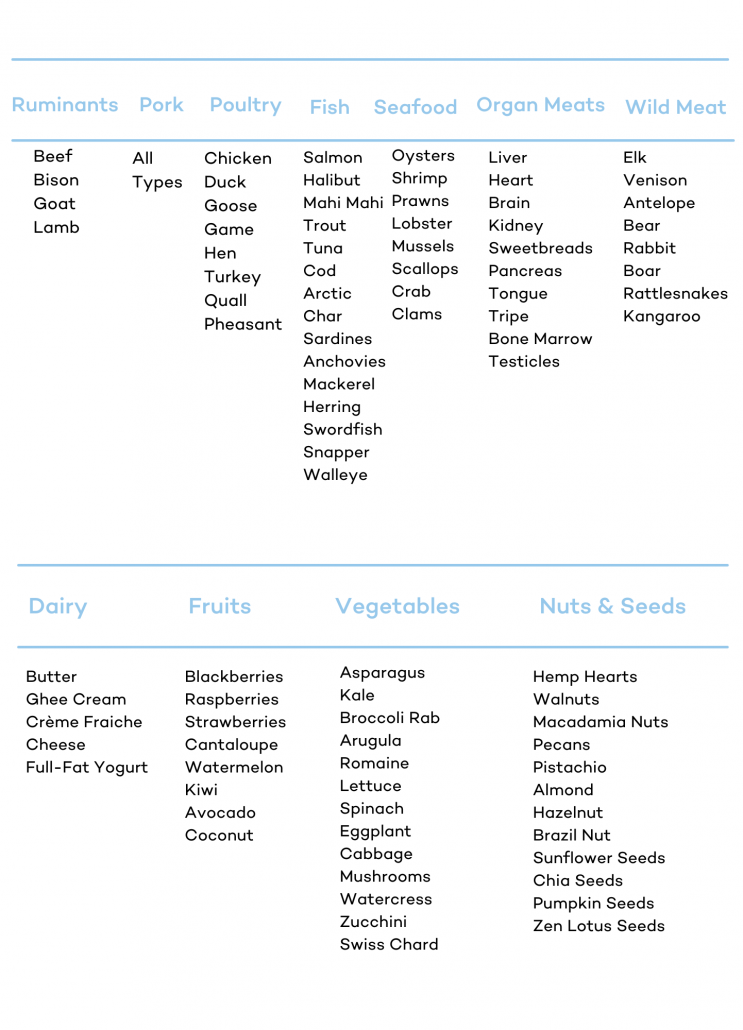
Ruminant Meats
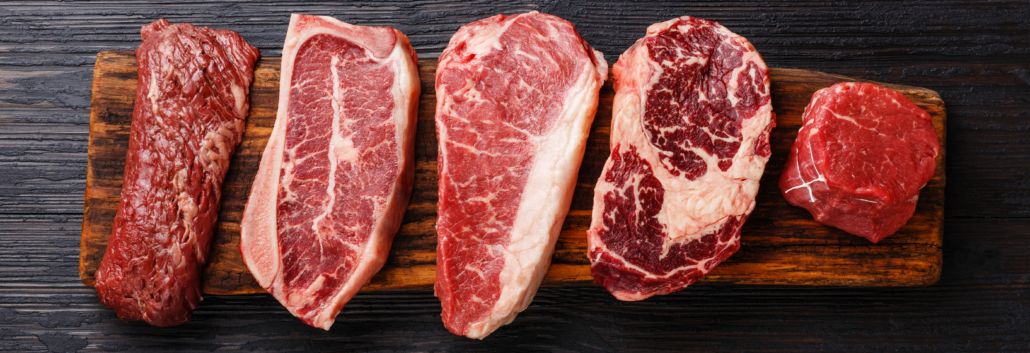
Ruminant meats are the foundation of most well-formulated keto and carnivore diet meal plans.
Unlike humans, ruminant animals have two stomachs. This makes them extremely efficient at extracting vitamins and minerals from plants. As Doctor Kiltz likes to say, “we came out of the trees to eat the grass eaters, not to eat the grass.”
Ruminant meats are loaded with B vitamins, zinc, and selenium along with meat specific compounds including:
- Carnitine: improves male fertility, reduces anemia, supports mitochondrial function, and cardiac ischemia. [7] [8] [9] [10]
- Carnosine: Heart and muscle protective. Prevents glycation, protects against telomere damage to prevent agings. [5] [2] [3] [4]
- Creatine: Associated with improved cognition and protection against Alzhiemer’s.Boost athletic performance, and heart health. [10] [11] [12] [13]
- Taurine: Antioxidant that reduces glycation, oxidative stress, and may reduce depression.
- Zinc: The zinc found in beef is 400% more bioavailable than you get in grains. Improves sperm count and mobility in men, while supporting a healthy immune system. [14] [15]
- Heme Iron: Found only in beef and other red meats, vital to healthy immune function, cognition, and energy metabolism. [16]
Grass-fed ruminants also contain significantly more Vitamin A (which you need to create energy) and Vitamin E (which assists in combating lipid peroxidation).
The most popular ruminants meats include:
- Beef
- Bison
- Lamb
- Goat
When choosing your ruminant meats select for the fatties cuts, and opt for grass-fed and pasture-raised varieties. These will have the healthiest fat composition and the highest amount of vitamins and minerals including vitamin A, and E.
Beef
Beef provides the above-mentioned nutrients at near-perfect ratios and in the most bioavailable forms for the needs of our bodies.
The list below ranks 10 of the most popular cuts of beef based on their fat to protein ratio.
Nutrition Info per 4 oz.
| Beef Cut | Calories | Fat | Protein | Carbs | % Calories from fat | % Calories from protein |
| Boneless short ribs | 440 | 41 | 16 | 0 | 84 | 15 |
| Tri-tip roast | 340 | 29 | 18 | 0 | 77 | 21 |
| Beef Back Ribs | 310 | 26 | 19 | 0 | 75 | 25 |
| Ribeye | 310 | 25 | 20 | 0 | 73 | 26 |
| Porterhouse | 280 | 22 | 21 | 0 | 70 | 30 |
| Top Sirloin | 240 | 16 | 22 | 0 | 60 | 37 |
| 80/20 Ground Beef | 307 | 19.6 | 30.5 | 0 | 59 | 41 |
| Skirt Steak | 265 | 16.5 | 27 | 0 | 58 | 42 |
| Brisket | 245 | 14.7 | 28 | 0 | 54 | 46 |
| Flank Steak | 200 | 8 | 32 | 0 | 36 | 64 |
Bison
Bison is often leaner than beef with a slightly different flavor, mainly due to their farming methods: Bison are almost always grass-fed and free-range, which also makes them a better choice for the environment than conventional beef. 7 8
The fat ratios of different cuts of bison will closely mirror those of beef in the chart above.
Lamb
Like beef, lamb is rich in fat, protein, and bioavailable nutrients. It’s especially high in zinc, B vitamins, the antioxidant glutathione, and conjugated linoleic acid (CLA). In fact, it’s higher in lamb than any other meat.
Studies show that CLA boosts the immune system, supports heart health, strengthens bones, and improves fat loss.8
While glutathione reduces insulin resistance, reduces the risk of autoimmune disease, along with oxidative damage, and symptoms of Parkinson’s disease. 9
Nutrition information per 4 oz.
| Lamb Cut | Calories | Fat | Protein | Carbs | % Calories from Fat | % Calories from Carbs |
| Chop/Rack | 330 | 22 | 30 | 0 | 63 | 37 |
| Loin Chop | 330 | 22 | 30 | 0 | 63 | 37 |
| Leg | 292 | 18.7 | 29.3 | 0 | 59 | 41 |
| Shank | 276 | 14.7 | 32 | 0 | 52 | 48 |
| Shoulder | 148 | 6 | 22.8 | 0 | 37 | 63 |
Eggs
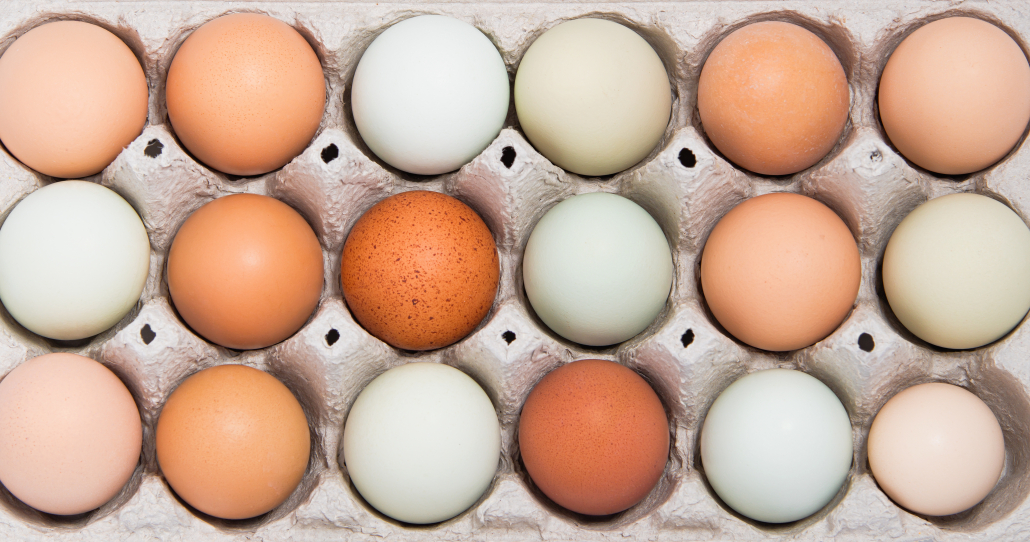
Eggs are one of the least expensive and most complete sources of fat and protein. Hard boiling this whole animal food makes for a great keto snack.
Loaded with B vitamins, choline, and folate, eggs are also a fantastic fertility diet food for women who are pregnant or trying to become pregnant. 10
| Nutrients | 100 grams (appx 2 eggs) | %Daily Value |
| Calories | 140 | |
| Fat | 10 | |
| Protein | 12 | |
| Vitamins and Minerals | ||
| Retinol (vitamin A) | 98mcg | 12% |
| Riboflavin | 0.4mg | 33% |
| Vitamin B12 | 0.33mcg | 100% |
| Biotin | 5.2mcg | 17% |
| Folate | 88mcg | 30% |
| Vitamin D | 7.9mcg | 30% |
| Vitamin E | 1.9mg | 30% |
| Pantothenic acid | 1.07mg | 22% |
| Phosphorus | 171mg | 25% |
| Iron | 1.8mg | Men (23%) Women (10%) |
| Selenium | 28mcg | 50% |
| Zinc | 1.0mg | 10% |
| Iodine | 47mcg | 33% |
Organ Meats

Nature’s most nutrient-dense superfoods, organ meats like bone marrow, liver, and brains were scavenged by our caveman ancestors long even before we were smart enough to hunt.
In fact, the human race can thank organ meats for fueling our evolution into the super-intelligent species we are today.
Organ meats have an extraordinary way of providing specific micro and macronutrients to the corresponding organs in our bodies.
For example, beef kidney contains special peptides that may benefit the health of our own kidneys. 11
Some of the most nutrient-rich beef organ meats you can eat on keto include:
Nutrients per 100 grams
| Nutrients | Liver | Heart | Kidney | Sweet- breads | Brain | Spleen | Tripe | RDA |
| Calories | 169 | 179 | 99 | 143 | 140 | 100 | 371 | – |
| Fat | 5g | 6g | 3.1g | 10.3 | 10 | 3g | 26g | – |
| Protein | 27g | 31g | 17.4 | 10.9 | 11 | 18g | 32g | – |
| Net Carbs | 5 | 0g | .3g | 1.1g | 1g | 0g | 0g | – |
| Vitamins | ||||||||
| Vitamin A | 870% | 2% | 2% | – | 7μg | – | – | 900mcg |
| Riboflavin (B2) | 263% | 76% | 2.8mg | .3mg | .2mg | .4mg | .359mg | 1.3mg |
| B6 | 79% | 9% | .7mg | .4mg | .2mg | .1mg | .162mg | 1.3-1.7mg |
| Folate (B9) | 290μg | 3μg | 98μg | 6μg | 3μg | – | 11mcg | 400mcg |
| B12 | 3464% | 280% | 280 | 15.2μg | 9.5μg | 5.7μg | 4.19mcg | 2.4mcg |
| Vitamin C | 1% | 0mg | 9.4mg | 3.3mg | 10.7mg | 45.5mg | 1.3mg | 60mg |
| Vitamin D | 8% | 1% | 1.1μg | – | – | – | .4mcg | 100mg (4000 IU) |
| Vitamin E | 3% | 14% | .2mg | – | 1mg | – | .39mg | 1000 mg (1500IU) |
| Vitamin K | 3% | – | – | – | – | – | 1.2mcg | 120mcg |
| Minerals | ||||||||
| Calcium | 0% | 0% | 13mg | 9mg | 43mg | 9mg | 77mg | 1300mg |
| Iron | 34% | 38% | 4.6mg | 2.2mg | 2.6mg | 44.6mg | 3.21mg | 18mg |
| Magnesium | 5% | 6% | 17mg | 15mg | 13mg | 22mg | 29mg | 420mg |
| Phosphorus | 49% | 27% | 257mg | 386mg | 362mg | 296.0 | 211mg | 1250mg |
| Zinc | 37% | 20% | 1.9mg | 1.4mg | 1mg | 2.1mg | 253mg | 11mg |
| Copper | 1621% | 72% | .4mg | .2mg | .3mg | .2mg | .22mg | .9mg |
| Manganese | 15% | – | .1mg | – | – | .1mg | – | 2.3mg |
| Retinol | – | – | 419μg | – | – | – | – | – |
| Selenium | 39.7mg | 21.8μg | 141μg | 26μg | 21.3μg | 62μg | 26.1mcg | 55mcg |
| Lycopene | – | – | 20μg | – | – | – | – | – |
| Thiamine | .2 | .2mg | .4mg | .1mg | .1mg | – | – | .9-1.2mg |
| Choline | 333.3mg | – | – | – | – | – | – | 550mg |
Organ Meat Supplements
If high-quality fresh organ meats are hard to come by, or they make you squeamish, not to worry. You can still get near identical benefits from dried organ meat supplements.
Click here to view our guide to selecting the best beef liver supplements, and here for our multi-organ meat supplement guide.
simply add beef liver supplements to your carnivore diet food list. You can learn more about supplementing with liver here.
Pork
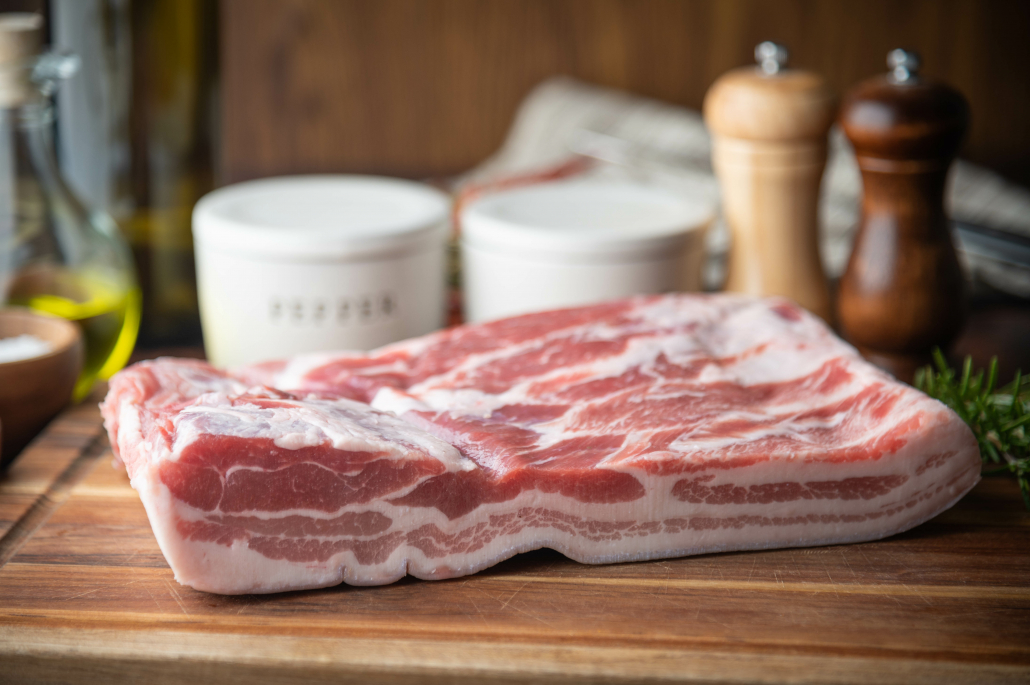
When it comes to answering, “what can you eat on a keto diet?” pork is near the top of most people’s lists.
However, pork often plays second fiddle to ruminant meats for the following reasons:
- Pork is less nutrient-dense
- Pigs can’t transform inflammatory omega-6 fatty acids in their feeds into omega-3’s, but ruminants can
- Pastured pork is hard to find, whereas grass-fed ruminants are common
That said, pork is still a fantastic whole food source of fat, protein, B vitamins, selenium, and choline.
Here’s a list of the top 10 cuts of pork to eat on a keto diet, listed in order of their fat to protein ratio.
Nutritional information per 4 oz.
| Pork Cut | Calories | Fat | Protein | % Calories Fat | % Calories Protein |
| Pork Belly | 588 | 60 | 10.4 | 92 | 7 |
| Baby back ribs | 315 | 27 | 18 | 77 | 23 |
| Pork Hocks | 285 | 24 | 17 | 76 | 24 |
| Shoulder | 285 | 23 | 19 | 73 | 27 |
| Bacon | 600 | 47.2 | 41.9 | 71 | 28 |
| Butt | 240 | 18 | 19 | 68 | 32 |
| Leg Ham | 305 | 20 | 30.4 | 59 | 40 |
| Loin | 265 | 15.5 | 30.8 | 53 | 46 |
| Chop | 241 | 12 | 33 | 45 | 55 |
| Tenderloin | 158 | 4 | 30 | 23 | 76 |
Whole Food Fats
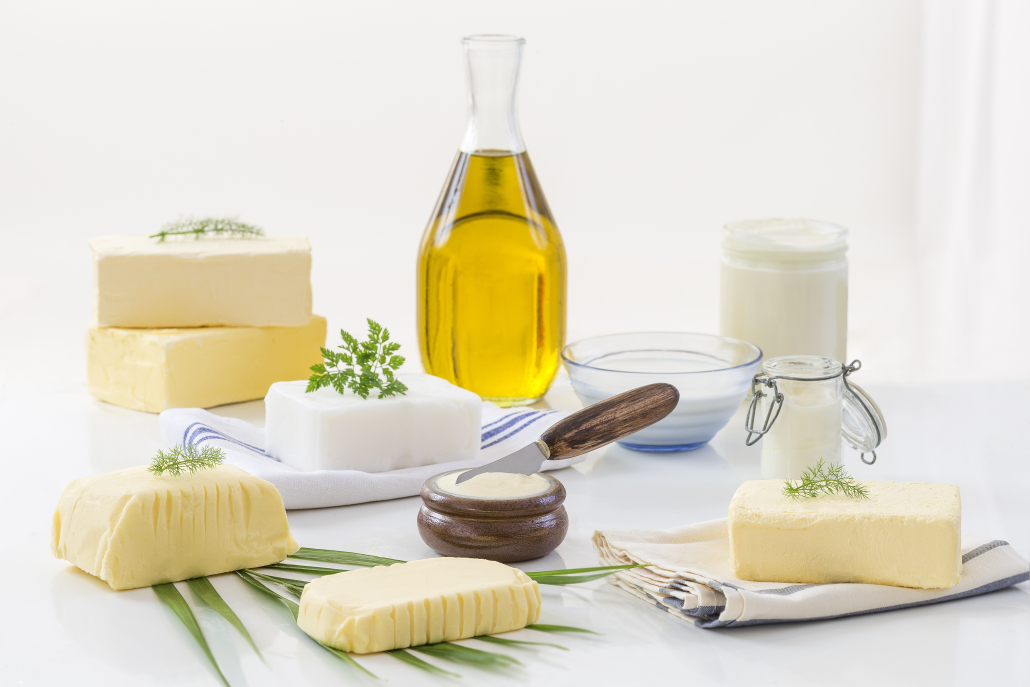
On a keto diet, it’s rarely a question of can you eat fat, and more a question of, have you eaten enough fat. Getting 70% of your calories from fat can feel daunting, even when you’re eating fatty animal foods. You’ll need to augment your keto meals with healthy keto fats.
8 of the healthiest fats you can eat on a keto diet include:
Let’s take a closer look at some of the best options you can eat on the keto diet:
Tallow
Incredibly nutrient-rich, beef tallow helps you absorb more essential nutrients from your food while providing vitamins A, D, E, K, and B1. Tallow also contains conjugated linoleic acid, a natural anti-inflammatory.
Ghee
A type of clarified butter, ghee is the result of removing milk solids and water through heat. Ghee is packed with vitamins K, A, and E, all of which are essential to numerous physiological functions. One of the best things about ghee is that it’s lactose-and casein-free, making it a great choice for people with lactose intolerance and dairy allergies.
Coconut Oil
Coconut oil is popular among keto dieters in large part because of their medium chain triglycerides (MCTs), that make up 54% of the fat in coconut oil. MCTs are directly metabolized into ketones, which help reduce some of the uncomfortable side effects when transitioning to keto. [23]
Fatty Fish
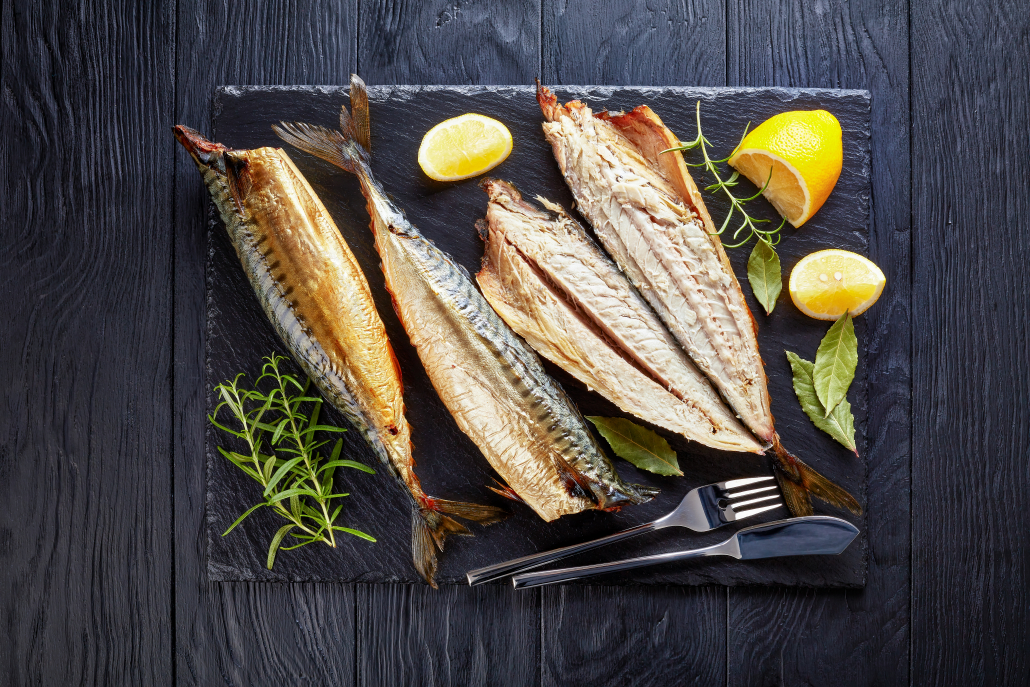
Though you can eat essentially all types of fish on a keto diet, most fish are relatively lean and will need to augment with added fats.
The fattiest fish are the center of pescatarian keto, and Mediterranean keto diets.
Fatty fish like Atlantic mackerel, sardines, and anchovies provide robust amounts of vitamin D–which can be hard to come by in food.
Here’s a list of the top 6 fish you can eat on the keto diet.
| TYPE OF FISH | CALORIES | FAT | PROTEIN | CARBS | % CALORIES FROM FAT | % CALORIES FROM PROTEIN | |
| #1 | Atlantic Mackerel | 290 | 20.3 | 27 | 0 | 63 | 37 |
| #2 | Farmed Arctic Char | 208 | 12 | 19 | 0 | 58 | 42 |
| #3 | Anchovies | 256 | 15.9 | 28 | 0 | 56 | 44 |
| #4 | Farmed Salmon | 234 | 14 | 25 | 0 | 56 | 44 |
| #5 | Wild King Salmon | 195 | 13 | 22 | 0 | 54 | 46 |
| #6 | Sardines | 139 | 8 | 19 | 0 | 50 | 50 |
Roe and Shellfish
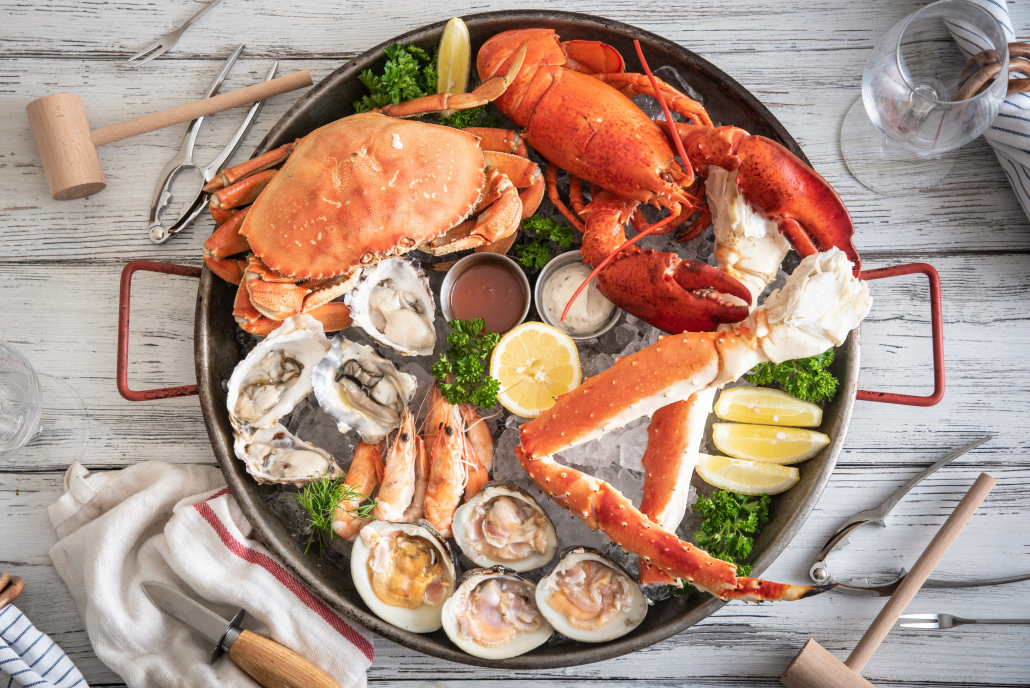
Eating roe and shellfish on the keto diet provides an abundance of hard to get nutrients. Oysters are loaded in zinc, while salmon roe is a rare source of significant vitamin C in animal foods.
Lobster, roe (caviar), shrimp, and other seafood with orange pigment provide a compound called Astaxanthin. [22] [23] This powerful antioxidant is around 6,000 times more potent than vitamin C. [24]
| Type of Seafood | Calories | Fat | Protein | Carbs | % Calories from fat | % Calories from protein | % Calories from carbs |
| Salmon Caviar (Roe) | 260 | 14 | 29 | 2.9 | 45 | 52 | 3% |
| Oysters | 58 | 1.9 | 6.5 | 3.1 | 29 | 33 | 28 |
| Mussels | 97 | 2.8 | 13.5 | 4.5 | 26 | 56 | 19 |
| Shrimp | 135 | 2.0 | 25.8 | 1.7 | 18 | 78 | 4 |
| Dungeness Crab | 107 | 2.0 | 22 | 0 | 17 | 82 | 0 |
| Lobster | 116 | 1.8 | 25 | 0 | 14 | 86 | 0 |
| Clams | 82 | 1.1 | 15 | 3 | 12 | 73 | 15 |
| Scallops | 97 | 1.0 | 19 | 3 | 9 | 78 | 12 |
Poultry
Poultry is accessible and relatively inexpensive, but it’s also very lean and is more highly processed and susceptible to contamination than other keto meats. For this reason poultry often plays more of a supporting role when it comes to what you can eat on the keto diet.
To get the most fat from poultry chose skin-on options, and add fats like tallow and butter when cooking.
And there is one type of poultry that’s highly recommended: chicken liver.
| Poultry | Calories | Fat | Protein | Carbs | % Fat | % Carbs |
| Goose | 340 | 24.9 | 28.5 | 0 | 66 | 34 |
| Game Hen | 220 | 16 | 19 | 0 | 65 | 35 |
| Chicken Wings | 320 | 22 | 30.4 | 0 | 62 | 38 |
| Chicken thigh (skin on) | 275 | 17.6 | 28.3 | 0 | 58 | 41 |
| Duck | 228 | 13.9 | 26.3 | 0 | 55 | 46 |
| Chicken Leg (skin on) | 275 | 15.2 | 29.4 | 0 | 54 | 46 |
| Turkey | 175 | 9.9 | 21 | 0 | 51 | 49 |
| Chicken Breast (skin on) | 200 | 8.4 | 31 | 0 | 38 | 62 |
| Chicken Breast (skinless) | 138 | 4 | 25 | 0 | 26 | 72 |
Full Fat Dairy
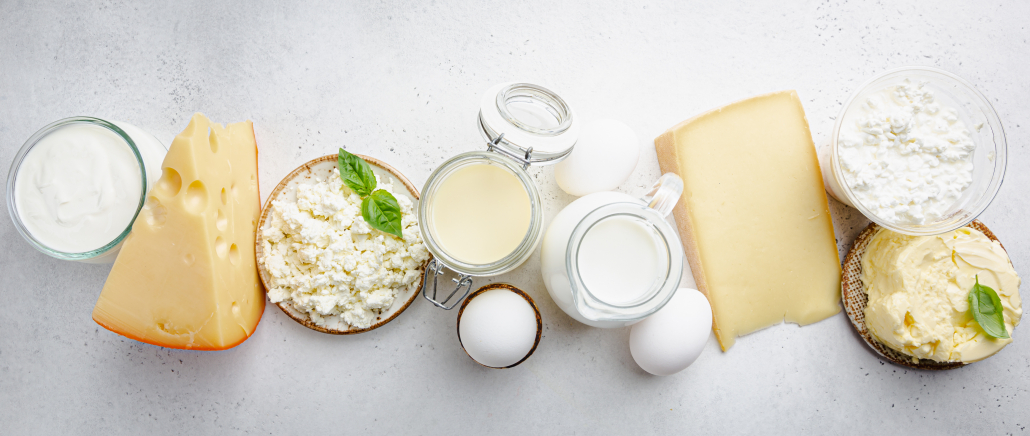
Keto yogurt, cream, butter, and keto cheeses make a fantastic addition for people that can tolerate dairy.
And for people who don’t tolerate dairy well, it’s worth giving A2 milk and dairy a try. A2 refers to a type of dairy protein. Most cows have A1, which breaks down into a molecule linked to autoimmune and heart disease. [36] [37] [38]
But the A2 protein in specific types of cows milk and exclusively in buffalo, sheep, and goat milk, can be safer and easier to digest.
A helpful tip is to add heavy cream to yogurt and cottage cheese to boost their fat ratio into keto territory.
Nutrition info per 100 grams
| Type of Dairy | Calories | Fat | Protein | Carbs | % Calories from fat | % Calories from protein | % Calories from carbs |
| Ghee | 896 | 104 | .3 | 0 | 100 | 0 | 0 |
| Butter | 714 | 84 | .8 | .01 | 99.9 | .01 | 0 |
| Creme fraiche | 403 | 43.2 | 2.4 | 2.4 | 96 | 2 | 2 |
| Heavy cream (3.3 oz) | 333 | 36.3 | 2.8 | 2.7 | 94 | 3 | 3 |
| Cream cheese | 352 | 34.5 | 6.2 | 5.5 | 87 | 7 | 6 |
| Sour cream | 192 | 18.4 | 2.3 | 4.5 | 86 | 5 | 9 |
| Cheddar cheese | 414 | 33.8 | 23.4 | 3.2 | 74 | 23 | 3 |
| Full Fat Greek Yogurt | 100 | 5.1 | 9.5 | 4.1 | 47 | 37 | 16 |
Low Carb Veggies
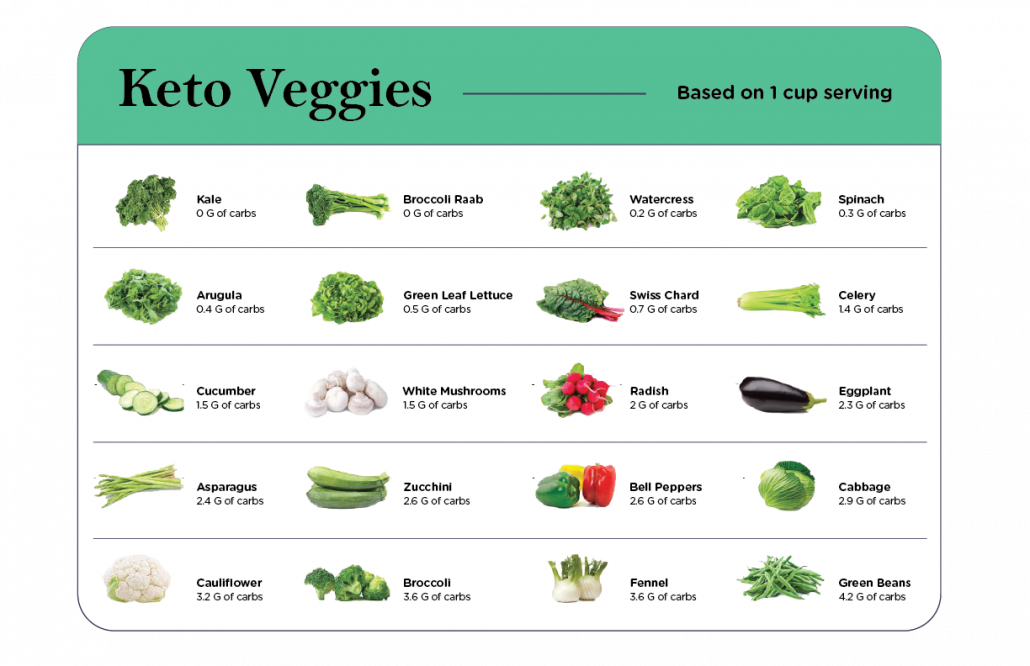
Veggies are a controversial topic on keto. Keto carnivore dieters swear off veggies altogether. Yet people eating vegetarian keto and vegan keto eat them all the time.
The argument for limiting veggies on a keto diet centers on a combination of carb load and the presence of plant toxins and antinutrients.
Plants contain thousands of these potentially toxic compounds including, phytic acid phytohormones, lectins, oxalate, and gluten.
In small doses most people are unaffected. But when constantly consuming plant toxins you can induce chronic inflammation and leaky gut among other disorders.
Below ground veggies, though often higher in carbs than their leafy counterparts, are generally lower in plant toxins. The higher carb options are best enjoyed once in a while, or as part of the cyclical ketogenic diet.
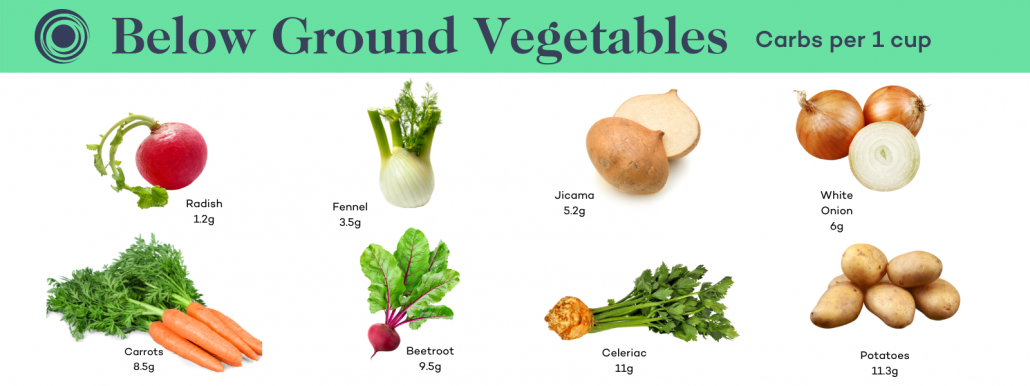
Can you Eat Fruit on the Keto Diet?
By virtue of their sugar content, fruit plays a minor role on the keto diet. The best fruit to eat on a keto diet are berries.
Berries are only 5-10% net carbs by weight. A cup of blackberries with heavy cream can be an occasional keto treat.
You’ll want to steer clear of bananas, which are over 20% net carbs.
The best keto fruits to eat on keto include:
| Types of Fruit You Can Eat on Keto | Carbs per 100 grams |
| Blackberry | 5 |
| Raspberry | 5 |
| Strawberry | 6 |
| Coconut | 6 |
| Lemon | 6 |
| Cantaloupe | 7 |
| Watermelon | 7 |
| Peach | 8 |
| Orange | 9 |
Nuts and Seeds
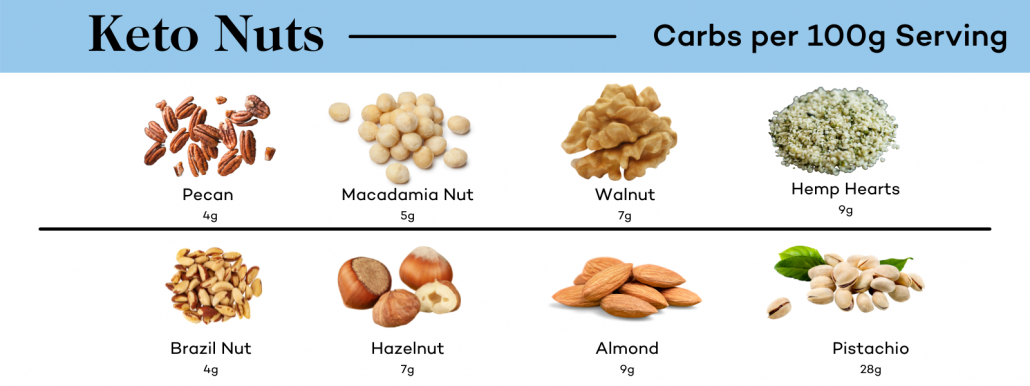
Though loaded with fat, protein, vitamins, and minerals, keto nuts and seeds should also be used sparingly on keto.
The drawbacks to nuts and seeds is that their extremely high in abrasive fiber, they can contain lots of antinutrients, and have extremely high omega-6 to omega-3 fatty acid ratios.
An ideal Omega-6 to 3 ratio is 1:1. But in our standard American diet, it’s closer to 1:16. This overabundance of omega-6’s can lead to chronic inflammation, cancer, and heart disease.
Here’s our list of the best low-carb nuts for a keto diet, ranked according to their carbohydrate content.
| Nut | Carbohydrate per 100g | Amount of nuts per 100g |
| Pecan | 4 grams | 65 nuts |
| Brazil nut | 4 grams | 20 nuts |
| Macadamia nut | 5 grams | 40 nuts |
| Hazelnut | 7 grams | 70 nuts |
| Walnut | 7 grams | 50 halves |
| Almond | 9 grams | 80 nuts |
| Hemp Hearts | 9 grams | 5/8 cup |
| Pistachio | 28 grams | 160 nuts |
Seeds can also make a cameo on most keto diets, but have the same potential drawbacks as nuts. Some popular options include:
| CARBOHYDRATES | PER 1OZ. | PER 100 GRAMS |
| PUMPKIN SEEDS | 1.4g | 4.9g |
| SUNFLOWER SEEDS | 1.7g | 6g |
| CHIA SEEDS | 2.2g | 8g |
Condiments and Sauces
Most commercial sauces and condiments are loaded with inflammatory vegetable oils and sugars. This can make eating out on keto a challenge.
However, there are fantastic keto options for most of your favorite condiments including, mayonnaise, bbq sauce, ketchup, aioli, mustard, and soy sauce.
Check out our guide to recipes and store-bought keto sauces and condiments here.
What Can you Eat on a Keto Diet? The Takeaway
A keto diet calls for high-fat, low-carb, and moderate-protein foods. So the answer to “what can you eat on a keto diet?” will naturally include the foods that most closely fit these criteria.
The keto-friendliest foods are whole food animals meats and fats.
Ruminant animal meats and fats from cows, bison, and lamb play the starring role. Pork, seafood, poultry, and full-fat dairy play supporting roles. With nuts, seeds, veggies, and fruits making occasional cameos.













